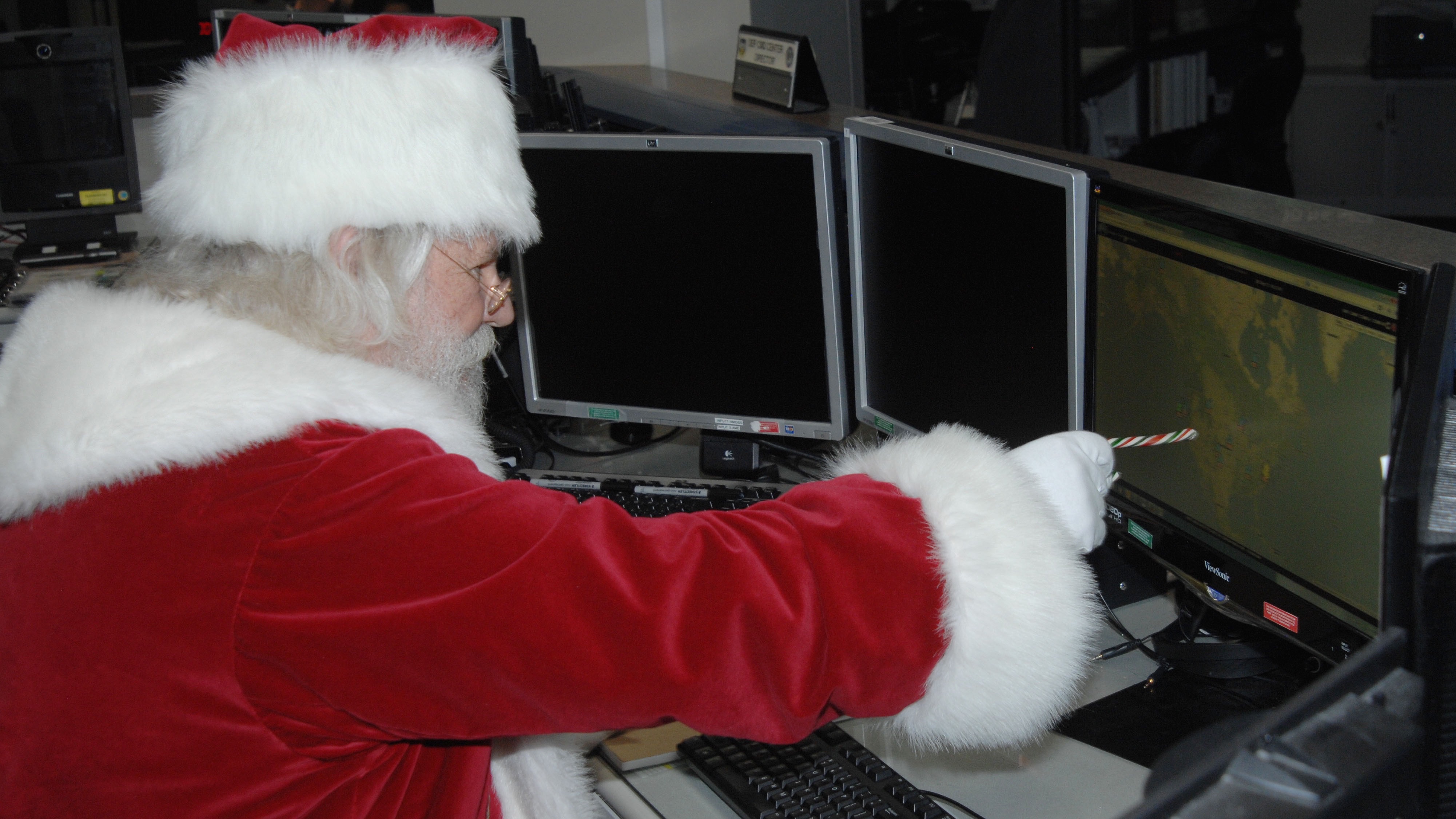
Santa Claus reviews his flight plan for his Dec. 25 trek across the globe in the North American Aerospace Defense Command and US Northern Command Current Operations Center
WASHINGTON: After years of diligently trying to track down the mystery of where Santa Claus begins his annual trip, I gave up, but was delighted to learn from very well informed sources that his route will embrace a stop at the International Space Station to deliver presents to the astronauts for the first time.
Santa’s swinging by to help them celebrate the twentieth year of humans living continuously in the station. (As I write this, NORAD has pinpointed Santa swinging by Valetta, Malta)
This is a step up from last year, when astronauts aboard the ISS merely assisted Santa with their unique tracking systems, when I was able to bring our readers super exclusive news that the astronauts aboard the International Space Station worked closely with NORAD to assist Santa Claus as he made his annual epic journey around the world.

Paul Graziani, AGI CEO
But I heard my new favorite Christmas story from Paul Graziani, CEO of Analytical Graphics (AGI), whose company provides much of the software that allows NORAD to track and help protect Santa on his global trip. Graziani, who won’t discuss details, says he’s met Santa several times and obviously has a special relationship with the bearded one. “Over the 23 years we’ve been doing this there have been some opportunities for me to meet Santa,” he told me.
But their relationship got off to a rocky start when, 23 years ago, AGI worked with NORAD for the first time to help track Santa and his sleigh. (NORAD, as Breaking D readers know. has been gainfully executing this mission since 1959.) Now some of you might think this is a simple task. Not true. “You never know where he’s going to go. When you’re tracking satellites or missiles or aircraft, they are kind of predictable. Santa, well, you never know where he’s going to go. It’s Santa and Rudolph deciding where to go,” says Graziani, clearly accessing some highly classified data he should not have shared! Graziani admits that they don’t know exactly where Santa starts his trip from, though they do work out a rendezvous, as best I could gather. Also, the trip involves an incredible number of stops and the weather varies hugely across the globe at this time of year.
(My relatives in Australia, for example, normally see Santa in shorts and he’s being pulled by six white boomers. They’re clearly an albino variant phase of the big Gray Kangaroo. Because it’s usually blazing hot top of summer in Australia, Santa is often left a bright cold beer — instead of milk and cookies — to help him make it through his grueling course.)
But let’s get back to Graziani’s story. That first year, AGI boasted roughly 50 employees. The Internet was pretty new to most of the world and folks were still learning the wonders of scalability. So AGI put together a program to help track Santa and hosted it on their servers. (If you don’t know what the cloud is, I’m not going to explain servers.)
“I come in on Christmas Eve morning and go to check the website,” Graziani relates. “It said 404 — site not available. The website was being completely overwhelmed by people trying to get to the website.” And AGI thought they had a really impressive setup back then, using a T1 line. They spent the entire day trying to get the website up. They “bought a bunch of servers.” They all crashed under the traffic. “We never caught up,” a chastened CEO admits.
But, in the best military tradition, the folks at NORAD turned around, and in Graziani’s words, “said, hey that was a great failure to have.” AGI and NORAD went to IBM for help. They had just executed the first truly Internet-savvy Olympics in Nagano in 1998 IBM used the infrastructure they’d built for the Olympics to help AGI and NORAD the next Christmas.
An IBM press release from the time puts all that data into perspective:
“Altogether a total of more than 4.5 terabytes — 4.5 trillion bytes (or characters of information) — of data were processed. This vast amount of information, an amount greater than all of the text contained in the U.S. Library of Congress, was used not only by countless fans around the world via the Internet, but also by over 82,000 accredited, on-site members of the Olympic family (including media, sports federations, National Olympic Committees, and athletes) through the Info ’98 intranet system.”
That was peanuts compared to the NORAD Santa tracking site. IBM executives told Graziani “they’d never seen so much data flowing out.” How much data? Let’s just say it “exceeded the data that had flown out from the Olympics.”
And that, children, is the story of scalability, Santa, the Internet and AGI. (AGI is in the process of being acquired for $700 million by Ansys, a company with whom they have worked closely for years. Graziani is one of AGI’s founders, so we’re guessing his corporate stocking will be well filled this year!)
We hope that NORAD, AGI, Verizon (who provide much of the infrastructure that allows kids to call NORAD), Santa and you all have a most MERRY CHRISTMAS this year.
Three reasons Russia dismissed Sergei Shoigu, its longtime defense minister
Andrei Belousov will be the third in a series of Russian Defense Ministers with no military experience and no background in national security matters.


























